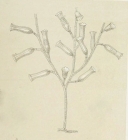
| Intro | | About | | Wiki | | Search traits | | Data explorer | | Literature | | Definitions | | Sources | | Webservices | | Statistics | | Feedback | | Editors | | Log in |
Hydrozoa taxon detailsTulpa Stechow, 1921
117038 (urn:lsid:marinespecies.org:taxname:117038)
accepted
Genus
Campanularia tulipifera Allman, 1888 accepted as Tulpa tulipifera (Allman, 1888) (type by original designation)
marine,
recent only
Stechow, E. (1921d). Neue Genera und Species von Hydrozoen und anderen Evertebraten. <em>Archiv für Naturgeschichte.</em> 87: 248-265., available online at https://www.biodiversitylibrary.org/page/45494398
page(s): 254 [details]
Taxonomic remark The distinctness of the genera Tulpa and Campanularia is arguable. Bouillon et al. (2006) kept them separate, but...
Taxonomic remark The distinctness of the genera Tulpa and Campanularia is arguable. Bouillon et al. (2006) kept them separate, but acknowledged that they might also be merged. The type species of Tulpa, Campanularia tulipifera, with its deep, tulipiform hydrotheca, is indeed rather distinct from most other Campanularia species. However, when comparing to the full variablitly within the genus Campanularia, it becomes difficult to draw a separation line. Notably, also the type species of Campanularia, C. volubilis, also has a deep, narrow hydrotheca. Some of the species here included in Tulpa have also often been attributed to the genus Campanularia. [details]
Schuchert, P.; Choong, H.; Galea, H.; Hoeksema, B.; Lindsay, D.; Manko, M.; Pica, D. (2025). World Hydrozoa Database. Tulpa Stechow, 1921. Accessed at: https://www.marinespecies.org/hydrozoa/aphia.php?p=taxdetails&id=117038 on 2025-05-09
Date action by 2006-09-28 06:51:36Z changed Martinez, Olga
original description
Stechow, E. (1921d). Neue Genera und Species von Hydrozoen und anderen Evertebraten. <em>Archiv für Naturgeschichte.</em> 87: 248-265., available online at https://www.biodiversitylibrary.org/page/45494398
page(s): 254 [details] basis of record van der Land, J.; Vervoort, W.; Cairns, S.D.; Schuchert, P. (2001). Hydrozoa, <B><I>in</I></B>: Costello, M.J. <i>et al.</i> (Ed.) (2001). <i>European register of marine species: a check-list of the marine species in Europe and a bibliography of guides to their identification. Collection Patrimoines Naturels,</i> 50: pp. 112-120 (look up in IMIS) [details] additional source Neave, Sheffield Airey. (1939-1996). Nomenclator Zoologicus vol. 1-10 Online. <em>[Online Nomenclator Zoologicus at Checklistbank. Ubio link has gone].</em> , available online at https://www.checklistbank.org/dataset/126539/about [details] status source Peña Cantero A.L. (2024a). New insights into the biodiversity of benthic hydroids (Cnidaria, Hydrozoa) from seamounts in the remote Macquarie Ridge, with the description of three new species. <em>Zoological Studies.</em> 63(17): 1-25., available online at https://doi.org/10.6620/ZS.2024.63-17 page(s): 15 [details] Available for editors From editor or global species database
Diagnosis Campanulariidae forming stolonal or branched colonies; hydrotheca very deep and large, tulip-shaped, with flared margin, narrowing under, usually longitudinally ridged or lined, without true diaphragm but with annular thickening; hydranth with distinct trumpet-shaped hypostome; gonophores as fixed sporosacs, gonothecae pedicellate, borne on hydrorhiza, annulated, planula developing inside gonothecae. [details]Taxonomic remark The distinctness of the genera Tulpa and Campanularia is arguable. Bouillon et al. (2006) kept them separate, but acknowledged that they might also be merged. The type species of Tulpa, Campanularia tulipifera, with its deep, tulipiform hydrotheca, is indeed rather distinct from most other Campanularia species. However, when comparing to the full variablitly within the genus Campanularia, it becomes difficult to draw a separation line. Notably, also the type species of Campanularia, C. volubilis, also has a deep, narrow hydrotheca. Some of the species here included in Tulpa have also often been attributed to the genus Campanularia. [details] |

